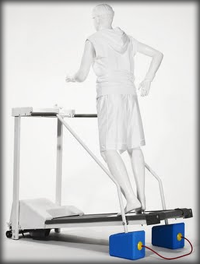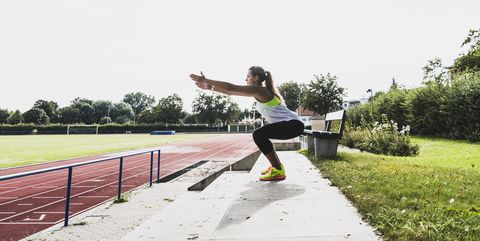You can’t buy motivation. Most runners probably wish they could.
We hit walls. Life can seem to get in the way of running–so having a playbook of motivational techniques is important for runners at every level who are fighting the same battle to log miles.
Running motivation can come in different forms when the finish line isn’t in sight–new running shoes, a new training plan, or even joining a running club. But at its purest, motivation is the human desire to do something; unlocking that desire may be even more difficult than the task itself.
Joshua Sommers finds it within himself–the hedge fund VP is also a triathlete who has competed in over 100 races. When asked what motivates him, he keeps it simple.
“The pursuit of excellence and self-improvement.”Joshua Sommers
We aren’t all like Joshua, but we can learn from him. In this piece, we’ll explore what types of motivational tools different runners can use, and how they can impact your training–and your life outside of running.
Motivation for Beginner Runners
As a new runner, it can be daunting to look at the miles ahead and know the only way to get there is with your own two feet.
Set a Goal
Begin at the end. Setting a goal provides something a runner can work toward. It can be a number of different things: maybe it’s weight loss, or picking a 5k race, or a certain number of miles a week, or even a half marathon. Whatever that goal is, keep it in mind each time you lace up those sneakers for a jog.
This will also help track progress. Write the goal down and place it somewhere you’ll see it every day, keeping markers of the steps taken to achieve it. After a few weeks, look back at the work accomplished and you’ll be able to see it actualized. See yourself achieving those goals and surpassing them.
Get Social While Holding Yourself Accountable
Incorporating a training partner into your new life as a runner has layered benefits. Finding a running partner will provide an immediate desire to run, even if simply knowing that person is counting on you.
Executing on a training program together, with a shared goal, can increase the level of accountability. Joining a running club or finding a running partner removes the element of choice, the ability to reason with yourself and find ways not to run. Excuses are ever-present, and a good running partner won’t take “no” for an answer.
Even though running is an individual pursuit, clubs and teams are everywhere. Besides the motivational aspect, things like networking and safety and developing a sense of community are all extended benefits of making running social.
Make it Routine
A morning run can ripple positively into the rest of your day. Acute aerobic exercise activates the prefrontal and occipital cortices in the brain, increasing “executive control.” This can help improve cognitive ability and can help control emotion. Morning runs can have effects that last into the night, like improving sleep quality. And it doesn’t stop there; studies suggest running can have overall health and cognitive benefits, especially later in life.
Besides the mental and physical benefits, there are less social obligations in the morning. You won’t get stuck at work or be tempted by a happy hour at 6am. Even if you’re not a morning person, you can likely train to become one. Pack all your running gear the night before. Set an alarm and place it across the room, forcing you to skip the snooze button.
Developing a morning running routine provides a nice reset of the body’s clock; it can feel like adding hours to the day. Another benefit? A solid training schedule can positively impact your regular schedule.
Ted Bross is a newly-graduated medical student starting his residency. He has participated in almost 30 ultra marathons, and developing a running habit helped him with medical school.
“Part of what helps me get through several of the mental stressors of medical school is pushing my body physically and relieving that stress. It makes me more of a disciplined athlete and is something that has given me a lot in my life.”Ted Bross
Develop a Training Plan
Checking boxes on a training plan can feel really good. It also answers some of the mental questions runners ask themselves before setting out: Where should I go? How long should I run? What pace am I aiming for? Just look at the running program, where it’s all outlined. Remember to develop your training plan in alignment with those goals you’ve set. And try to incorporate one long run per week.
A comprehensive training plan should incorporate all aspects of your routine. Account for extra pre-run warm-ups and post-run stretches. Add in weekly or monthly goals. Budget some days off. Your training plan doesn’t have to be a bible, but should be a document frequently returned to, and one around which other aspects of life can be considered.
“I train on average for about ten sessions a week, for a total of ten hours a week,” Sommers said. “I’m spending all this time on it, so I want to get the most out of my workouts.”
Use the mind to drive the body forward
There’s exciting new research investigating how the mind affects physical performance, which we use in our content for athletes. Subscribe to learn more.
Motivation for Experienced Runners
There’s a fine line between getting into a groove and finding yourself in a rut.
Buy Some New Gear
Sometimes you need to pick low-hanging fruit. Purchasing some new running clothes, like a new pair of running shoes or running shorts, can provide motivation to run and test all that new gear. Depending on what you buy, it may also improve your training (like a fitness tracker).
New gear can also serve as a reward; small goals can be treated as important steps to accomplishing larger goals.
There’s also the “gear guilt.” Shiny new toys should be used instead of sitting in the back of a closet. Some may think using money as a type of running motivation is shallow, but there are few drivers in life like cold hard cash.
Introduce Supplements
So much of success when running comes before (and after) feet hit the pavement. Nutrition should be looked at holistically, because supplements can provide a boost during the run and also help with recovery.
“Especially in the longer races, figuring out nutrition is something most people don’t spend enough time on.”Ted Bross
Pre-run supplements include caffeine for energy, calcium for bone health and even creatine to reduce muscle inflammation. Post-run, focus on protein for muscle recovery and fish oil to reduce muscle soreness.
HVMN Ketone, a ketone ester drink, can be used both as a pre-run supplement and a recovery mechanism. By elevating ketone levels in the blood, HVMN Ketone unlocks a fuel source the body produces naturally, one fundamentally different from carbohydrates or fats. Post-workout, taking HVMN Ketone can expedite the resynthesis of glycogen (by 60%) and protein (by 2x), which enable faster recovery.
Cross Train
Varying training can provide easy motivation to try a new sport–one you know can improve your running–and it’ll also keep you active on days you’re not running. It can also supplement during rehabilitation periods from physical injury, and improve overall physical performance.
Specifically, cross training can improve VO2 Max capacity (the measurement of the maximum amount of oxygen utilized during intense exercise). Swimming and cycling are great choices, but things like yoga can also increase flexibility and balance.
By introducing strength workouts or cross training into your regimen, motivation can be found in presenting new challenges and accomplishing new goals.
Switch Up Locations
Don’t become a running rodent. Running on a treadmill can feel like a hamster on a wheel, just like running the same path multiple times a week can feel Groundhog Day-esque. The essence of running harkens back to being outside, and in a more spiritual sense, connecting with the space in which you’re traversing.
It’s easy to feel invigorated by discovering a new place or hitting a new distance, so trail running or cross country running are always good motivators for the simple fact that they place you out of your element. The simple feeling of dirt under the feet and soaking up the essence of the trail provides an immediate lift and motivation.
We’ve also heard from runners that there’s something special about running in the rain (even if it’s the last thing you want to do). It presents a new challenge, and almost a primal sense of motivation; you’re miles away from home, and the only way to return is to run back. Your heart is pounding, you smell the rain, each wet step is experienced in a totally new way–it’s an hour that can feel different than all the other hours in the day.
Motivation for Advanced Runners
Advanced runners can have the most difficult time finding motivation because running is such a part of their life that it becomes an unquestioned obligation.
Remember (and Embrace) the Pain and Vulnerability
Stop and ask yourself: Why do I run? If running has become numbly intrinsic, this question can serve as a reinvigorating reminder to look within and remember why you fell in love with running in the first place.
Because running is hard; it hurts; it requires time; it takes mental fortitude. Some might think this is admitting defeat–but reminding yourself that you’re accomplishing something difficult can inspire you to keep going.
In a physical sense, powerful running comes from your core. So, in essence, you’re running from the gut. There’s something vulnerable about exposing yourself in that way, and showcasing the ability to be broken down (and thus built back up).
It can all come to a head at the end of a race. Ted Bross has been there.
“You share some really special moments. You’re pretty raw emotionally, when you get broken down physically there’s less barrier to connect with people.”Ted Bross
Ditch the Tech (This Includes Music)
Technological tools have forever changed running, giving anyone the opportunity to track pace and miles and calories burned. These also changed training by providing actionable targets to hit and measure performance.
Select one day to run untethered by technology. It can serve as a great way to reconnect with the simple joy of running, ditching the gadgets to escape the metrics. Sometimes you have to operate on feel, and it can be motivating to find that energy within yourself instead of hitting a number on your wrist. Some of your best runs aren’t necessarily your fastest.
Many of us train with music, but that can act as a barrier between you and the world in which you’re running. If you’re participating in a race that doesn’t allow music, it’s especially beneficial to train without tunes and run to the beat of your own pace.
Improve Your Diet
Seeing results provides motivation to continue working. The results garnered from eating healthy show themselves in training. While carb-loading has been a staple of many runners’ race day routines, growing evidence suggests that a periodized approach to nutrition is optimal, especially for long distance races. For example, a marathon runner might undertake periods of training with a low-carb, high-fat diet, to boost fat burning followed by maximizing carb fueling for a race.
Exercise after an overnight fast can also increase fat oxidation, which can help with weight loss and, when the body gets better at burning fat, it can also help increase endurance.
Taking HVMN Ketone can provide some of the benefits of ketosis without the necessary dieting or extreme fasting.
“My diet isn’t as good as I would like it to be,” admitted Sommers. “But that’s more a function of time and other stress factors, like if I’m traveling or if I don’t have time to cook what I want.”
Even the most elite triathletes struggle to incorporate diet into life.
Trying a new diet can have results both in training and recovery, and noticing the difference provides a motivation to continue pushing your personal best with newfound fuel. But that happens on an even smaller level. Incorporate a new fruit or vegetable into your diet.
Haven’t had Brussel sprouts since your grandma served them boiled? Give them another try (and maybe try roasting them) and fold in more vegetables over the course of your training.
Even for those unwilling to make extreme dietary changes, there are incremental benefits to be had by cutting back on refined sugars, avoiding seed oils and getting plenty of omega 3s.
Enjoy the Small Wins
Advanced runners arrive at a point where they can only improve so much. It’s a point of fear for many–that they’ll plateau, and eventually decline.
So the small wins are important to celebrate. Seconds off your mile pace, or increased weight while strength training or even a feeling of energy after a run–individually these are small, but together they can make a big impact. The world’s elite athletes understand the power in recognizing small successes.
Testing of HVMN Ketone illustrated that athletes go ~2% further in a 30 minute time trial.9That can mean the difference between placing on race day and looking up at the podium, a desire shared by the crop of marathoners and cyclists and NFL teams and world champions in boxing and MMA who are all using HVMN Ketone.
Accomplishing small wins while training provides a motivation to keep achieving them, and the confidence they’ll translate to race day.
Motivation is an Endless Cycle
Remember: motivation comes and goes. But recognizing when you’ve lost motivation is almost as important as getting it back.
The struggle challenges all different levels–from beginner to expert runners. On the running journey, goals will be accomplished, routines will become stale, good habits will wane. This is all part of the process.
Finding the ability to motivate yourself won’t just improve your running. It’ll improve your life overall, and some of these strategies should translate to life off the running road.
Go forth. Run. And maybe find a bit of yourself in the process. \
Give your motivation a boost
Adding supplements or specific training techniques can help power the body through those final miles. We’re publishing new content for athletes–subscribe to stay ahead of the pack.
This article was originally published at HVMN
Source: hvmn.com






 2. Hustle. Go after every ball, even if you don’t think that you can get it. Go for every ball like it’s your last hit, giving it your all each and every time you’re on the court. If you’re in it 110%, everyone else will feel the pressure, too. Soon enough, your entire team will be firing on all cylinders
2. Hustle. Go after every ball, even if you don’t think that you can get it. Go for every ball like it’s your last hit, giving it your all each and every time you’re on the court. If you’re in it 110%, everyone else will feel the pressure, too. Soon enough, your entire team will be firing on all cylinders 3. Communicate with your teammates. The game of volleyball relies on good communication and the best team on the court is usually the team talking the most. Call “got” or “mine” really loud to avoid confusion between you and your teammates. Yell whether the ball is in or out. If you see a tip coming let your team know. Your whole squad will benefit from just one person talking.
3. Communicate with your teammates. The game of volleyball relies on good communication and the best team on the court is usually the team talking the most. Call “got” or “mine” really loud to avoid confusion between you and your teammates. Yell whether the ball is in or out. If you see a tip coming let your team know. Your whole squad will benefit from just one person talking. 4. Be coachable. Good volleyball players know that they always need to get better. Learning to take constructive criticism and suggestions for improvement is an important part of improving your play, whether you’re on a volleyball team or playing informally with friends. If someone, a coach or a teammate, makes a suggestion, listen openly and try to integrate new ideas into your practice routine. Make it a goal to get better.
4. Be coachable. Good volleyball players know that they always need to get better. Learning to take constructive criticism and suggestions for improvement is an important part of improving your play, whether you’re on a volleyball team or playing informally with friends. If someone, a coach or a teammate, makes a suggestion, listen openly and try to integrate new ideas into your practice routine. Make it a goal to get better. 5. Be a mentally tenacious player. If you hit a ball out or shank a pass, try to stay positive. Just move on and focus on the next serve. Volleyball is a mental sport and by getting down, you will greatly impact your game in a negative way. Stay focused and intent on winning. Find the zone and stay there. When your teammates see you playing with intensity and poise, it’ll rub off on everyone and improve the team as a group.
5. Be a mentally tenacious player. If you hit a ball out or shank a pass, try to stay positive. Just move on and focus on the next serve. Volleyball is a mental sport and by getting down, you will greatly impact your game in a negative way. Stay focused and intent on winning. Find the zone and stay there. When your teammates see you playing with intensity and poise, it’ll rub off on everyone and improve the team as a group. 6. Encourage your teammates. High-fives, vocal encouragement, and positive vibes should always be coming from good players. Whether you’re on the court or on the bench, always be cheering your team on and focused in with the game.Be alert, even if you are winning with a 10-point lead, the game could easily turn around with a good server. Focus on seeing a game through till the end and not changing your focus until the job is done.Be a good sportsperson. Know that even if you don’t win, you can always play another game and hit the ball twice as hard next time. Your teammates will appreciate your good attitude, regardless of your performance.
6. Encourage your teammates. High-fives, vocal encouragement, and positive vibes should always be coming from good players. Whether you’re on the court or on the bench, always be cheering your team on and focused in with the game.Be alert, even if you are winning with a 10-point lead, the game could easily turn around with a good server. Focus on seeing a game through till the end and not changing your focus until the job is done.Be a good sportsperson. Know that even if you don’t win, you can always play another game and hit the ball twice as hard next time. Your teammates will appreciate your good attitude, regardless of your performance.




 2. Hustle. Go after every ball, even if you don’t think that you can get it. Go for every ball like it’s your last hit, giving it your all each and every time you’re on the court. If you’re in it 110%, everyone else will feel the pressure, too. Soon enough, your entire team will be firing on all cylinders
2. Hustle. Go after every ball, even if you don’t think that you can get it. Go for every ball like it’s your last hit, giving it your all each and every time you’re on the court. If you’re in it 110%, everyone else will feel the pressure, too. Soon enough, your entire team will be firing on all cylinders 3. Communicate with your teammates. The game of volleyball relies on good communication and the best team on the court is usually the team talking the most. Call “got” or “mine” really loud to avoid confusion between you and your teammates. Yell whether the ball is in or out. If you see a tip coming let your team know. Your whole squad will benefit from just one person talking.
3. Communicate with your teammates. The game of volleyball relies on good communication and the best team on the court is usually the team talking the most. Call “got” or “mine” really loud to avoid confusion between you and your teammates. Yell whether the ball is in or out. If you see a tip coming let your team know. Your whole squad will benefit from just one person talking. 4. Be coachable. Good volleyball players know that they always need to get better. Learning to take constructive criticism and suggestions for improvement is an important part of improving your play, whether you’re on a volleyball team or playing informally with friends. If someone, a coach or a teammate, makes a suggestion, listen openly and try to integrate new ideas into your practice routine. Make it a goal to get better.
4. Be coachable. Good volleyball players know that they always need to get better. Learning to take constructive criticism and suggestions for improvement is an important part of improving your play, whether you’re on a volleyball team or playing informally with friends. If someone, a coach or a teammate, makes a suggestion, listen openly and try to integrate new ideas into your practice routine. Make it a goal to get better. 5. Be a mentally tenacious player. If you hit a ball out or shank a pass, try to stay positive. Just move on and focus on the next serve. Volleyball is a mental sport and by getting down, you will greatly impact your game in a negative way. Stay focused and intent on winning. Find the zone and stay there. When your teammates see you playing with intensity and poise, it’ll rub off on everyone and improve the team as a group.
5. Be a mentally tenacious player. If you hit a ball out or shank a pass, try to stay positive. Just move on and focus on the next serve. Volleyball is a mental sport and by getting down, you will greatly impact your game in a negative way. Stay focused and intent on winning. Find the zone and stay there. When your teammates see you playing with intensity and poise, it’ll rub off on everyone and improve the team as a group. 6. Encourage your teammates. High-fives, vocal encouragement, and positive vibes should always be coming from good players. Whether you’re on the court or on the bench, always be cheering your team on and focused in with the game.Be alert, even if you are winning with a 10-point lead, the game could easily turn around with a good server. Focus on seeing a game through till the end and not changing your focus until the job is done.Be a good sportsperson. Know that even if you don’t win, you can always play another game and hit the ball twice as hard next time. Your teammates will appreciate your good attitude, regardless of your performance.
6. Encourage your teammates. High-fives, vocal encouragement, and positive vibes should always be coming from good players. Whether you’re on the court or on the bench, always be cheering your team on and focused in with the game.Be alert, even if you are winning with a 10-point lead, the game could easily turn around with a good server. Focus on seeing a game through till the end and not changing your focus until the job is done.Be a good sportsperson. Know that even if you don’t win, you can always play another game and hit the ball twice as hard next time. Your teammates will appreciate your good attitude, regardless of your performance.








:max_bytes(150000):strip_icc():format(webp)/Screen-Shot-2016-11-29-at-12.01.43-PM-583dc2a55f9b58d5b1322120.png)
:max_bytes(150000):strip_icc():format(webp)/Screen-Shot-2016-11-29-at-12.14.56-PM-583dc5ba5f9b58d5b13270f6.png)
:max_bytes(150000):strip_icc():format(webp)/Screen-Shot-2016-11-29-at-12.03.26-PM-583dc3865f9b58d5b13249fe.png)
:max_bytes(150000):strip_icc():format(webp)/Screen-Shot-2016-11-29-at-12.07.02-PM-583dc3e23df78c6f6a2674f3.png)
:max_bytes(150000):strip_icc():format(webp)/Screen-Shot-2016-11-29-at-12.08.13-PM-583dc4295f9b58d5b1324df3.png)
:max_bytes(150000):strip_icc():format(webp)/Screen-Shot-2016-11-29-at-12.10.19-PM-583dc4a43df78c6f6a267b71.png)
:max_bytes(150000):strip_icc():format(webp)/Screen-Shot-2016-11-29-at-12.14.11-PM-583dc5893df78c6f6a26850a.png)





